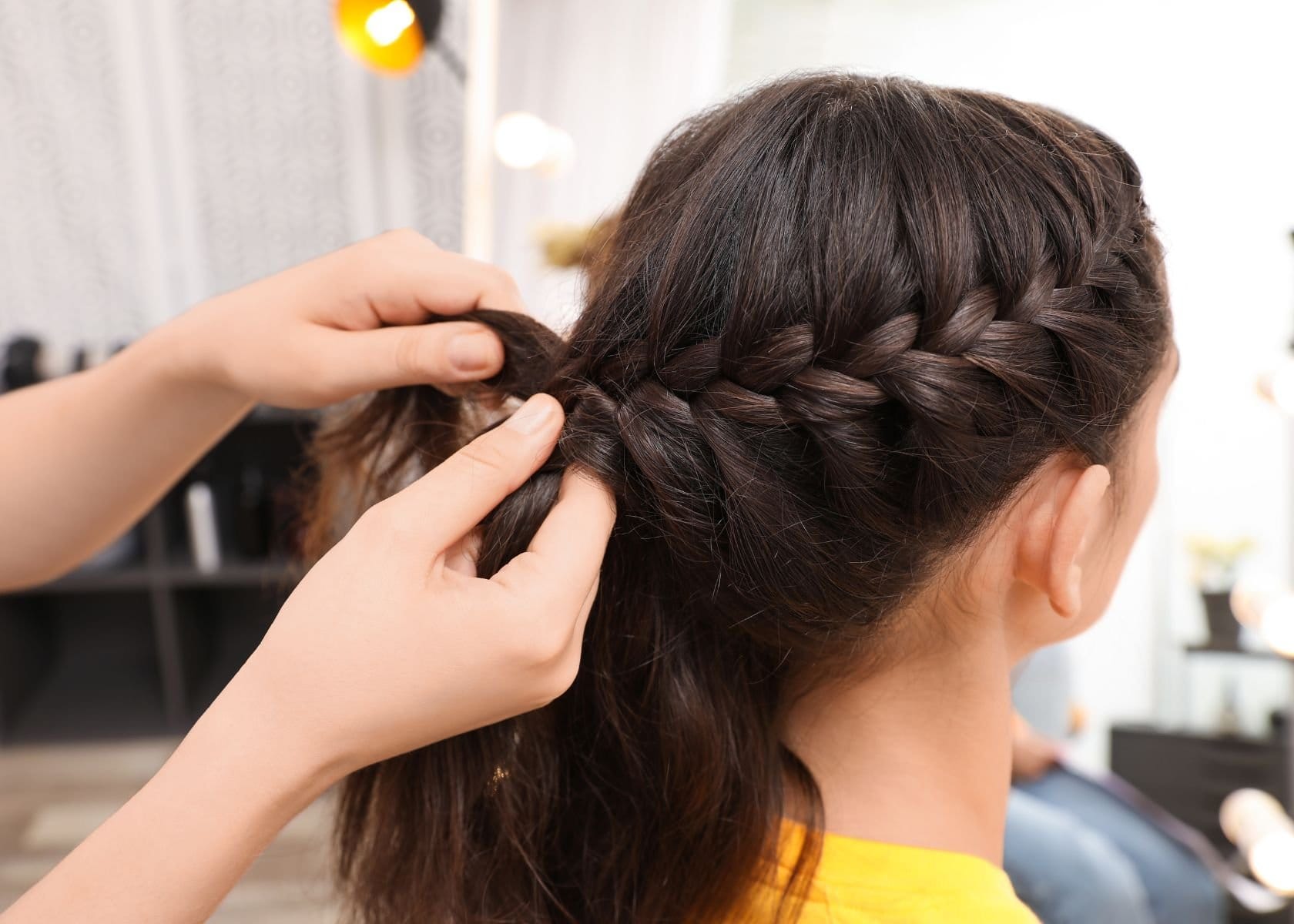Are you struggling with a bumpy wig fit because your natural hair refuses to lay flat underneath? You're not alone. Many people who wear wigs deal with the tricky task of smoothing down their hair so that the wig sits neatly and looks as natural as possible.
It's important to find the right method to flatten your thicker hair effectively, or else you might end up with an uneven-looking wig that just doesn't feel right.
Did you know that a simple cornrow style could be your best friend when it comes to prepping your hair for a wig? It's one of several hairstyles designed specifically to keep your strands tucked away and flattened.
We have gathered all the expert tips and tricks to help ensure that from now on, every time you don a wig, it will look flawless and feel comfortable. We'll walk through everything from basic preparation steps like parting and brushing down to how exactly you can secure those pesky locks safely under any kind of wig.
Keep reading – we have solutions for short hairs, long hairs, thick manes, and more!
- Start by brushing and slicking back your hairline, applying gel to keep flyaways flat, and securing loose ends with bobby pins. This creates a smooth surface for the wig.
- Part your hair down the middle before braiding it into cornrows or use a wig cap to ensure an even base, which helps prevent lumps under the wig.
- Try hairstyles like cornrows, flat twists, or a low bun underneath the wig cap to keep your natural hair compressed and out of sight for a more natural look.
- Use bobby pins and clips to secure both the wig cap and the actual wig in place; adjust as needed for comfort and fit without any bumps or bulges.
- When wearing long hair under a wig, consider braiding or creating wide flat pin curls before placing on the wig cap to help maintain an even base.
Preparing Your Natural Hair for a Wig

Before applying a wig, it's important to prepare your natural thick hair by brushing and slicking back the hairline, parting the hair down the middle, and either braiding or using a wig cap.
These steps will ensure that your natural hair stays flat and smooth under the wig for a flawless look.
Brushing and Slicking Back Hairline
Start by brushing your stray hairs away from your face to create a sleek surface for the wig. Use a fine-tooth comb or brush to gently smooth down any bumps or knots near the hairline. This will help you achieve that slicked-back look, which is essential for a seamless wig application.
Apply a small amount of gel or pomade along your hairline after brushing to keep those flyaways flat and in place. Smooth this over with your brush again, directing all strands toward the back of your head.
Using long strokes ensures every hair complies and lies as flat as possible, setting an excellent base for hiding natural hair under the wig.
Secure any loose ends with a bobby pin if needed, especially around the nape of your neck, where hair can be stubborn. These steps not only prepare your locks for donning a wig cap but also contribute significantly to maintaining a natural-looking outline once you wear the wig.
Parting Hair Down the Middle
Parting your hair down the middle can create a smooth and even base for wearing a wig. This technique allows you to divide your hair evenly on both sides, making it easier to distribute the weight of the wig cap. You can also use a few drops of hair oil.
By parting your hair in this way, you ensure that no lumps or bumps form under the wig, resulting in a more natural and comfortable fit.
Parting hair down the middle also helps with braiding or tucking your natural hair underneath the wig cap. Once divided, you can easily braid each section for added security and flatness under the wig.
Braiding or Using a Wig Cap
To prepare your natural hair for a wig, you can achieve a flat surface by braiding or using a wig cap. Here are the steps to follow:
- Braiding: Divide your hair into sections and braid it close to the scalp. This method helps in keeping the hair flat and secure under the wig.
- Wig Cap: Place a wig cap over your natural hair, ensuring that it lays flat against your head. Tucking any loose hairs into the cap will create a smooth surface for the wig to sit on.
- Strategic Hair Placement: If you choose not to braid, strategically positioning the hair under the wig cap can help in achieving a flat appearance without wrapping braids.
- Securing Long Hair: For long hair, using a wig cap and braiding or twisting the hair before putting on the cap can help create an even base for the wig.
- Concealing Short Hair: A wig cap can effectively hide short hair when combined with strategic placement and smoothing techniques.
- Ponytail Method: If preferred, gathering the hair into a low ponytail before placing it on the wig cap can also assist in securing and flattening long or short hair under the wig.
Three Easy Hairstyles for Hiding Your Hair Under a Wig

To ensure a smooth and flat surface for your wig, consider trying out cornrows, flat twists, or a low bun to hide your natural hair underneath. These hairstyles will help keep your hair in place and make it easier to apply and wear the wig.
Cornrows
To create cornrows for wearing a wig, wrap or part your hair into sections. Braid each section close to the scalp in neat rows. Start at the front and work your way back. Secure the ends with small elastics or clips.
Cornrows keep hair flat and smooth under a wig, minimizing bulk and ensuring a snug fit. This method works especially well for longer hair and can be combined with a wig cap for added security.
Flat Twists
Flat twists are a great way to flatten your hair for a wig. These twists can provide a smooth base for your wig, keeping your hair flat and secure. To create flat twists, follow these steps:
- Start by parting your hair into sections using a hot comb.
- Take two small sections of hair at the front and cross them over each other.
- Add a small section of hair from the scalp to each twist as you go.
- Continue twisting and adding small sections of hair until you reach the back of your head. It will only take a few minutes and won't be time-consuming.
Low Bun
To hide your natural hair under a wig, creating a low bun is a simple and effective method. Here are the steps to achieve this look:
- Gather your hair into a low ponytail at the nape of your neck.
- Twist the ponytail into a tight bun and secure it with a hair tie or bobby pins.
- Ensure that the bun is laying flat and close to your scalp to avoid any bumps under the wig.
How to Flatten Hair for Wig - FAQs
Preparing your natural hair to comfortably fit under a wig cap is an important but potentially tricky process. Simply throwing on a wig without properly flattening and securing the hair underneath often leads to lumps and bumps that make the wig noticeably unnatural.
The steps required to get a smooth, flat fit differ depending on your hair type and length. Common questions covered below include how to best tame thick, curly hair before wig application as well as how to temporarily flatten short to medium length locks.
What's the best way to flatten hair for a wig?
To flatten your hair for a wig, braid your hair in cornrows or tie it back into a sleek ponytail, then use a wig cap to hide and smooth out any bumps.
How can I hide my natural hair under a wig if it's long?
You can hide long hair under a wig by braiding it close to your scalp or creating flat ponytails before covering it with a wig cap for that extra sleek look.
Is there an easy method to lay short hair flat under a wig?
Yes, you can slick back short hair using styling products and secure it with bobby pins before putting on a snug-fitting wig cap to keep everything in place.
Can I wear my hair under the wig without doing cornrows or braids?
Sure! For those who don't want braids or cornrows, try tying your hair into flat pigtails around the head or using gel to slick it down before applying the wig cap.
Are there special hairstyles recommended when preparing my own hair to wear under wigs??
Wig preparation is key; consider hairstyle options like low-profile cornrows, flat twists, or wrapped ponytails designed specifically as foundation styles for wearing wigs smoothly.
Conclusion
The techniques discussed offer practical and efficient ways to flatten your hair under a wig. Have you considered trying these methods for hiding your natural hair under a wig? Flattening your hair is crucial for achieving a flawless wig look.
These strategies can have a significant impact on enhancing your overall appearance. Explore additional resources to further refine your hair preparation techniques.
In the comments below, let us know which methods you use to flatten your hair before wearing a wig.
Read More About Wig Tips and Tricks





